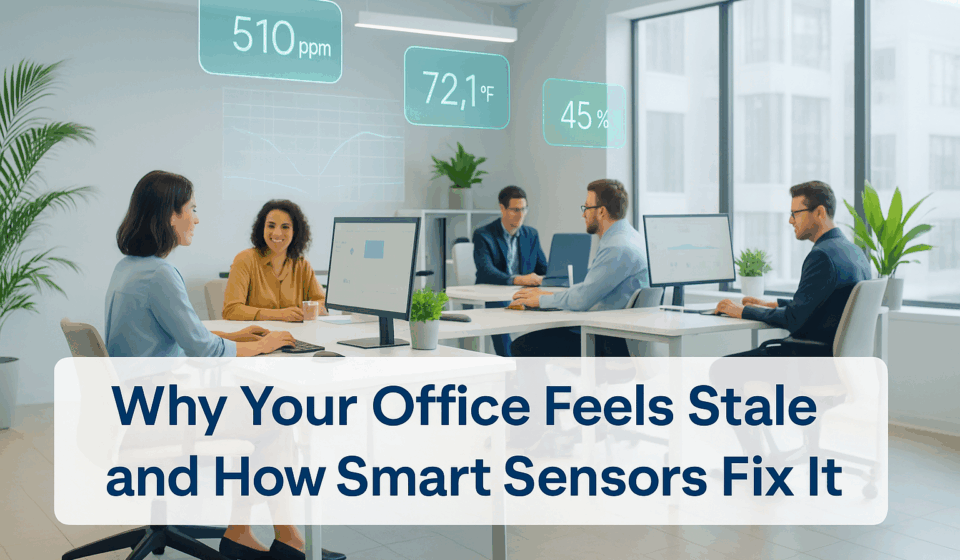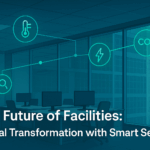
Why Your Office Feels Stale and How Smart Sensors Fix It
If your office sometimes feels stuffy, heavy, or just… off, you’re not imagining it. Many workplaces struggle with “air quality at work” and comfort issues that build up throughout the day. The result is fading focus, mid-afternoon headaches, and a general sense that the space isn’t helping you do your best.
This article explains what’s really going on and how modern office comfort tech can turn it around—quickly, affordably, and without drama.
What makes an office feel “stale”?
Several invisible factors drive comfort. On their own, they may be small, but together they shape how you feel.
- CO₂ rises as people breathe in shared spaces. High CO₂ can make rooms feel sleepy and reduce focus.
- Temperature drifts with sun, occupancy, and equipment loads. A couple of degrees can change comfort a lot.
- Humidity that’s too low dries eyes and skin; too high feels muggy and amplifies odours.
- Particulates (PM2.5/PM10) from outdoor air or indoor activity can irritate lungs.
- VOCs from cleaning, furniture, and printers add to that “stale” smell.
- Light and noise levels also affect comfort and productivity.
Traditional systems set fixed schedules and hope for the best. But buildings are dynamic. People move, meeting rooms fill, and the weather changes. Yesterday’s settings won’t match today’s needs.
What “good” air and comfort look like
You don’t need to become a facilities expert to know when a space feels good. Great offices share a few traits:
- Stable temperature, not swings
- Balanced humidity, not dry or sticky
- Fresh-feeling air, with CO₂ kept in check
- Low particulates and VOCs, so the space smells clean, not chemical
- Lighting and acoustics tuned for the task, not the worst-case
When these variables stay within healthy ranges, people feel more alert, collaborate more easily, and get more done—without reaching for another coffee.
How smart sensors fix stale offices
Here’s where modern office comfort tech shines. Smart sensors, backed by AI-powered environmental monitoring, continuously measure all the key variables in real time, build a picture of each zone, and trigger adjustments before people even notice a problem.
- See what’s happening: Live dashboards reveal CO₂, temperature, humidity, PM, VOCs, light, and noise for each room or floor.
- Act automatically: Integrations nudge ventilation, filtration, and setpoints to keep conditions in the sweet spot.
- Prevent issues: If a meeting room’s CO₂ climbs, ventilation ramps up; if afternoon sunlight heats a corner, cooling adjusts.
- Prioritise hotspots: Alerts flag rooms that routinely drift out of range so facilities teams can focus effort where it counts.
- Guide simple fixes: Sometimes the answer is easy—shift a schedule, move a printer, adjust cleaning products, or add a purifier.
By combining smart building data with smart occupancy sensors, facilities teams can fine-tune ventilation, lighting, and comfort strategies for different zones. The big win is consistency. Instead of reacting to complaints, buildings stay comfortable all day.
DIREKS’s approach: real-time insight, real results
At DIREK, we built D-XPERT® as part of our smart building management solutions, making comfort and ‘air quality at work’ simple for occupants and actionable for building teams.
What D-XPERT® does for you:
- Monitors continuously across CO₂, temperature, humidity, particulates, VOCs, light, and noise—room by room.
- Analyses patterns to understand occupancy-driven changes and time-of-day trends.
- Optimises automatically through smart rules or integrations with your building systems.
- Delivers clear reports that show which spaces are improving and where to tweak next.
- Keeps everyone aligned—tenants, managers, and owners see the same insights, with the right level of detail for each.
For occupants and tenants, the experience is simple: spaces feel fresher, more stable, and more supportive of focused work. For building managers, it’s a measurable improvement without guesswork.
Quick wins you can start today
You don’t need a major retrofit to feel a difference.
- Measure first: Even a small pilot of sensor nodes will show where and when conditions drift.
- Tackle CO₂ hotspots: Adjust ventilation schedules for peak times; consider demand-controlled ventilation where possible.
- Tune setpoints: Narrow the temperature band to smooth out swings; align with the real occupancy pattern.
- Reduce sources: Relocate printers, review cleaning products for VOCs, and maintain filters on time.
- Share the wins: Let teams know what’s improving—it builds trust and reduces complaints.
D-XPERT® helps you do all of this with live data and simple controls, so improvements stick.
The bottom line
Stale-feeling offices aren’t a mystery. They’re the result of a few variables drifting out of range as the day evolves. With smart sensing, clear insight, and light-touch automation, you can keep comfort steady and energy use sensible.
If you want a workplace that feels fresh from the first meeting to the last email, explore how DIREK and D-XPERT® can help. We’ll show you exactly what’s happening in your space—and how to fix it fast.
Sina Mehdigholi
Sina Haji Mehdigholi is an energy systems engineer with over 8 years of hands-on experience in building management systems, energy efficiency, and smart building automation. At DIREK, he blends engineering insight with AI to shape sustainable and intelligent environments.
Follow Me